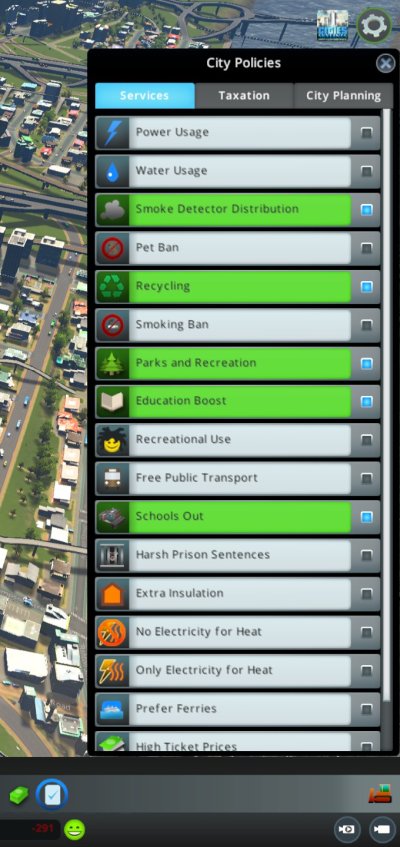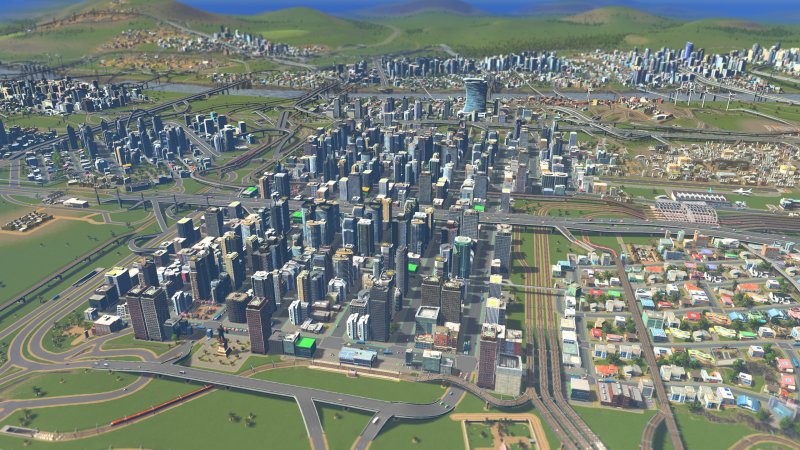Updated: June 17, 2020
Remember my mega city built in SimCity 4? An endeavor that took me three years to complete, and resulted in a beautiful region with some 4.3 million citizens? Well, I decided to try something similar in Cities Skylines, a most excellent city building simulation.
If you've been reading my game reviews, then you know that I really like Cities Skylines. Over the past several years, with many an hour spent warming up my house with excess heat from the intense CPU and GPU workloads generated by the ravenous Cities Skylines simulation engine, I set about cracking the game's secrets, including compiling three traffic optimization guides. These should help you create the perfect road grid for your city to flourish and grow. And by grid I mean roundabout. Now, implementing my own advice, I went about building a lovely city, and the result is now here before you.

Game mods
First, let me set the rules. Vanilla game - well, with After Dark, Snowfall and Mass Transit expansions, with only a single third-party mod - the one that unlocks all 25 tiles. Other than that, I use the Unlimited money mod, because otherwise, it would take a long time to reach the point of profitability, and be able to grow fast.
I didn't go for any custom stations or architecture, and didn't make any other aesthetic changes, apart from what the game allows. It is possible to make really cool cities with third-party stuff, but my idea was to see what I could achieve by playing the stock simulation, including its (under-optimized) traffic path finding algorithms.
Planes, trains, automobiles
Well, in a nutshell. Roads. This is the heart of the matter. Cities Skylines is a game of road network optimization, with some extra props thrown into the equation. Having learned through trial and error what not to do, I went about the following setup:
- Separate neighborhoods that eventually merge into a single metropolis via highways. The neighborhoods are typically grid-shaped, with overpass highway connections that have off and on ramps on alternating six-lane streets for high-density areas and ordinary two-way roads for low-density suburbia. All roads have cycle lanes, except the industry, where they are unnecessary. Large roundabouts help districts merge smoothly. The majority of roads are overground, with only an occasional tunnel connecting remote neighborhoods.

Looks busy and chaotic, but it actually makes sense.
- Public transit - My typical setup includes a centrally placed airport side by side with a single large, six-track station (with an underground metro connection) as the hub for incoming external rail, with expanding circular lines (rings) going to the different districts in the city. The rail is used for longer-distance traffic. I use metro for medium distances, and buses for shorter distances plus an occasional hood-to-hood connection. I've managed to avoid the in-game line creation bug limit, and my overall traffic throughput stands at about 75%, brought down primarily by the over-busy industry sector.

Airport, metro, six-platform rail station, highway connection, and a bunch of bus stops - the city's heart.

As the city expanded, I had to add a second airport, to accommodate all the tourists.
- For aesthetic purposes, I added an odd overground rail line and alike, but these are never profitable, and you can't really use them for high-volume traffic. If you have excess money, you can play around, for fun, but remember this doesn't really make any strategic difference.
- Then, there's walking and cycling. Skyliners like to walk, and will gladly do that over long distances. Thus, all my 'hoods are set up with tons of footpaths, including overhead bridges that run across entire grids, and connect onto the adjacent areas. I also use cycle paths to connect more distant parts of the city, although technically, the pedestrians and cyclists will share the footpaths just fine, without any friction, not like in the real world.

I will walk 500 miles ...
Housing and commerce
I normally go for a 50:50 split between high-density and low-density residential, with commerce and office space thrown in accordingly. I have also set a tax relief policy for high-density residential areas, which means almost constant demand for housing, plus a reasonable availability of the necessary workforce to sustain the industry. That does not mean I deprive my citizens of goods, oh no. They get proper education, plenty of parks and recreational areas, good sanitation and health, and all the rest of it. This results in the buildings and offices all maxing up, which means more moneh for me taxes, hence a profitable and happy city.



Various policies that help keep the Skyliners happy. Industry 4.0 is really important.
Industry
I did create one large zone in the center of the city - this turned out to be a bit of a mistake, as the trucks kept clogging my highways, using the same roads as the people and buses going about their daily commute. I did eventually disperse the rest of it around - tiny local industries, plus dedicated mining and farming, but I never really solved the jam around the central airport. I did carve some wider roads, added extra highway connections, but that particular area remains quite busy.

The first industry zone - too busy.

A bunch of farms on the eastern side of the city.

Ore mining - gritty, as it should be.
Other things
Plenty of solar powerplants, plenty of water pumps - but they do bring the water level down, so at some point, you will have to switch to water towers. Cemeteries also demand their space, but they make people happy. You also have to handle trash, and the thing is, if you have landfills, your garbage trucks will dump stuff there rather than take it to incinerators. So you might want to go frugal and have no landfills.
Unique buildings are quite important, as they help bring in tourists - especially once you unlock some of the special ones (like the Space Elevator). As soon as I placed it, there was a massive surge in visitors, with just that one prop drawing roughly 1,000 people at any given time. I also saw my profit grow as a result, and the demand for residential and office spiked.


What about the processing power for all this?
Well, I got meself a new desktop not that long ago. With its mighty GTX 2080 graphics card, the bulk of the workload is actually done in the GPU, so that's nice. However, the resource usage does go up over time, and with some 200K people in the city, there's a fair deal to compute and simulate. I ended up with the GPU utilization at about 37-38%, and the CPU at about 26-27% (for all 16 threads) - in other words, roughly four full CPU cores. This means there's more to be done for sure. The system temperatures weren't excessive, more or less as I've previously reported. So I have more room to grow my city, if I want to. Possibly up to 300-400K, provided there's enough room on the 25 tiles to actually build.
End result
Splendor and fun. I talked about profitability in my many reviews of the game, and I've managed to maintain a healthy margin. It also depends on your current industry throughput and all that, but I was able to stay some 40-50K Cities monies in the green, rarely dipped into the red, and even hit the high 65K profit at roughly the 150K citizen count. That translates into about 35% margin, which I like to consider the game efficiency ratio.

Money, ta-da-da-da-da-da ... it's a blast.



If you want to improve your traffic - one-way it ... all the way. Roundabouts!

It's not all grid - some urban mess adds realism.


Conclusion
Here we go. A beautiful, flourishing, dynamic city, with extra cash, good traffic flow, and continuous demand for growth. I managed to do this without using third-party network mods, as I did in SimCity 4, or any other prop or asset that would alter the default balance of the game. Cities Skylines can sometimes be quite frustrating, especially when cars start doing crazy U-turn maneuvers just to save 2px worth of distance and none of the time, but it is manageable. The flaws in the path finding actually make the game unpredictable and thus even more enjoyable.
I was able to hit the 200K mark after about 20 hours of playing. I'm thinking of starting a fresh city, with an even more optimized layout. My goal is to try to hit 85% network efficiency, remain cash positive, and push through onto an even higher citizen mark. Maybe do this with one of the Boreal maps, and also try some of the custom assets, which might make the city layout even more realistic and fun. All in all, I'm enjoying this a great deal. If you have any asks or suggestions, feel free to email me. And away, me goes, onto me next building adventure!
Cheers.